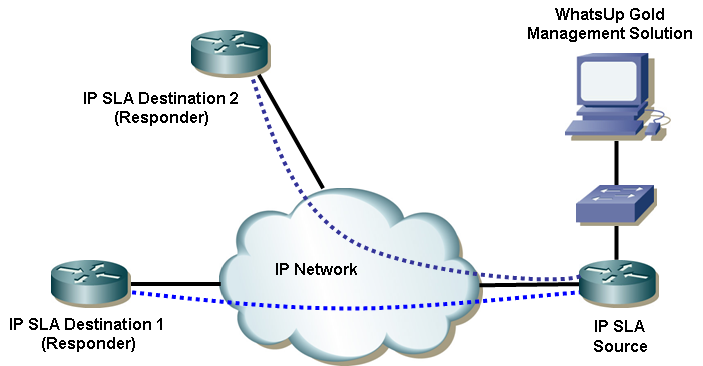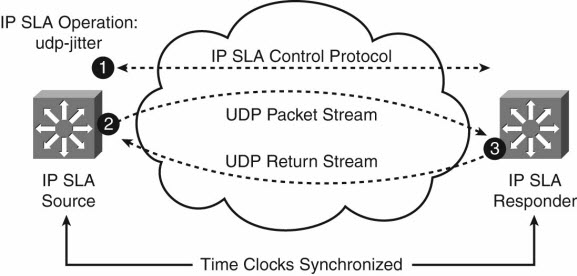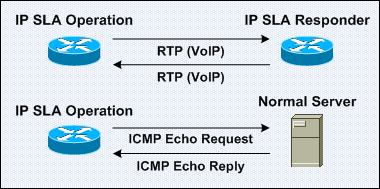IP SLA use the concept of an operation. Each operations define the type of packet that the router will generate.
IP SLA features measures the ongoing behavor of the network.
IP SLA act as a tool to test and gather data about the network.
IP SLA can be combine with PBR and static route. This combination provides to control when the static and PBR paths are used or ignored .
IP SLA operation types available :
ICMP( echo jitter )
RTP ( VoIP)
TCP
UDP ( echo,jitter )
DNS
DHCP
HTTP
FTP
Configuring and Verifying IP SLA :
1. Create the IP SLA operation and assign an integer operation number
(config)#ip sla (#)
2. Define the operation type and parameters
For ICMP echo you define de destination IP address or Host name and optionally the source IP address .
(config-ip-sla)#icmp-echo ( destination address or hostname ) source-ip ( source ip address or hostname ) or source interface
3. “Optional” Define a ( non default) frequancy at which operation shouldsend the packets in seconds using the frequency (seconds) IP SLA subcommand.
4. Schedule when the SLA will run
(config)#ip sla schedule “X” start-time “X” life “X”
5. Define an object that tracks the SLA probe
(config)#track (#) ip sla (#) state
Dont forget to enable the policy route map on the interface .
Show ip sla configuration
Show ip sla statistics (#)
TRACKING SLA Operation to influence Routing
![]()
You can configure both static routes and PBR to be used only when an SLA operation remains successful.
A good reason why Cisco use the tracking object is to prevent Flapping route .Flapping route is when a router adds a route to its routing table then quickly removes it , condition change causing the route to be added back to the table and so on …..If a static route tracked an IP SLA object directly the SLA object return code could change each time the operation ran cause a route Flap.The tracking object concept provides the ability to set a delay of how soon after a tracking state change the tracking object should change state. This give the engineer a tool to control route flaps.
Configuration of a static route to track an IP SLA Operation
Use the track object-number ip sla sla-ops-number state reachability global command
(config)#track (#) ip sla (#) state
Optional Configure the delay to regulate flapping of the tracking state by using the delay command
(config-track)#delay up (#) down (#)
Then configure the static route with the ip route command
(config)#ip route x.x.x.x x.x.x.x (interface) track (#)
Configuration PBR to Track an IP SLA
Instead of using the command set ip next-hop x.x.x.x in PBR configuration command, use the command :
set ip next-hop verify-availability x.x.x.x (#) track (#)
Dont forget to enable the policy route map on the interface .
Another example from Cisco:
<ip sla 1 < The number 1 here is arbitrary, used only to identify this sla. It is otherwise known as the operation number>
icmp-echo 4.2.2.2 < 4.2.2.2 is a DNS server that responds to pings out on the internet>
timeout 500 < This is how long to wait for a response from the ping>
frequency 3 < This is the repeat rate for the SLA>
ip sla schedule 1 start-time now life forever < This command says “start SLA 1 now and keep it running forever>
track 1 rtr 1 reachability < This comand creates the track object “1” and monitors the SLA 1>
now for the routing, we need to change the default route and associate it with the tracker
no ip route 0.0.0.0 0.0.0.0 1.1.1.1
and then put it back with the tracking
ip route 0.0.0.0 0.0.0.0 1.1.1.1 track 1
Then we need to add our secondary route
ip route 0.0.0.0 0.0.0.0 1.1.1.2 10 <we set this route with a higher metric than the tracked route>
ip route 4.2.2.2 255.255.255.255 1.1.1.1 ==> 1.1.1.1 being your primary next hop ip address
Now when the ping to 4.2.2.2 fails the primary route is removed and the secondary route with the higher metric becomes the default.
The route will be reinstated when the connectivity is restored.
>









